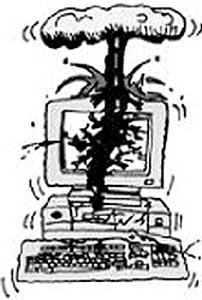![[Metroactive Features]](/features/gifs/feat468.gif)
[ Features Index | San Jose | Metroactive Central | Archives ]
 SGI Goes Bust, Part 1 An insider talks about the 'Gee Was' company By Annalee Newitz WE'RE MEETING IN SECRET and he's using a pseudonym, but Dominic is still nervous. He's about to spill his guts about the financial implosion at SGI--formerly known as Silicon Graphics, formerly known as the "gee whiz" company whose graphics workstations set the industry standard, and formerly the corporate love of Dominic's professional life. But the romance is over. And although Dominic mutters some anxious words about the way SGI detectives have a tendency to track down and fire people who leak company secrets, his anger has finally overridden his fear. He wants to talk, and he wants it published for the valley to see. I ask him to recollect his first day at SGI six years ago, back when the company was reaching its peak. He was one in a bushel of hires that day. In typical Big Silicon Valley style, he and his fellow newbies were given T-shirts ("the best computer company on the planet!" they blared), piled in a company bus and treated to a free lunch at the SGI cafeteria. "I remember thinking the whole place was so cool, like a college campus," Dominic says dreamily. "They called themselves employee-centric, and they really were. Anyone could just speak his mind. During orientation they even told us about sgi.bad-attitude, a newsgroup where people could go to bitch about the company." Dominic believes the absolute high point of SGI's reign was in 1994 when Business Week did an article on SGI and dubbed it "The Gee Whiz Company." Enthuses Dominic, "We had finished with Jurassic Park and morphing was still a cool new thing that had been done first on our computers. SGI was rocking." Around that time, SGI paid Huey Lewis and the News to play its annual company picnic, where they gave out beach towels that read "Gee Whiz--1.5 Billion Dollars." Those were its yearly sales. Describing SGI back then, Dominic uses the word "glitz" a lot. To him, SGI was all glitz and stardust--it was an unstoppable powerhouse, its computers perfectly crafted to produce state-of-the-art glamour, excitement and beauty. But that was precisely when things started to go wrong. "It wasn't apparent that bad things were happening," Dominic assures me. "Everybody thought the Cray deal was the slickest thing in the world. We thought we were invincible, and it made sense that we were buying the flashiest company out there as far as name recognition goes." Of course Dominic heard the rumors that everyone else in the industry heard. SGI CEO Ed McCracken was a technology adviser to President Clinton, so when the Cray deal went down, people said McCracken was doing Clinton a favor. Using SGI's muscle, he would protect Cray and keep the U.S. supercomputer business competitive with Japan. At the time, Dominic thought the rumors were ridiculous. Now he's not so sure. "Looking back, I can see the danger signs," he says. "Cray people started appearing in key management positions at SGI. That seemed odd. "Think of it this way--if you buy a used car from people who really mistreated it, why would you ask those people to take care of your nice, shiny car for you?" The end times really got rolling when SGI started to do the Microsoft tango. Sooner or later, it happens to most of the great companies in the industry. Like hopeless love addicts, they convince themselves that although Microsoft used and discarded all its other mates, things will be different with them. It will be different because they are the one. Dominic sighs and fiddles with the dinner he's ordered as we talk about SGI's downward spiral into Microsoftitis. "We had done wonderfully with the INDY, our low-end UNIX workstation, and it was time to replace it. "TJ, our CEO at the time, had this idea that we were going to follow the INDY by competing with NT, essentially out-PC-ing the PC. I think the beginning of our undoing was when we were a good year late to market with the INDY's follow-ups, the 02 and the Octane. By the time we got these machines out there, they just weren't up to snuff." Gradually, SGI became entirely focused on NT. Dominic recalls, "Eventually, after TJ left, the company decided we needed an NT workstation. And the only way to beat 'em was to join 'em. That's when everything went to hell. We began a line of thinking that killed SGI. It destroyed us." "So what went wrong with the Microsoft deal?" I ask. Now Dominic is seriously stressed. "This is sticky," he quavers. "I can't tell you everything I know. But I will tell you about the NT machines whose code names were Hugh and Borg." To be continued ... Annalee Newitz is a surly media nerd and it won't cost you anything to send her email, violently disagree with her, or write her love letters at tabloid@jps.net. [ San Jose | Metroactive Central | Archives ]
|
From the October 28-November 3, 1999 issue of Metro, Silicon Valley's Weekly Newspaper.
Copyright © 1999 Metro Publishing Inc. Metroactive is affiliated with the Boulevards Network.
For more information about the San Jose/Silicon Valley area, visit sanjose.com.